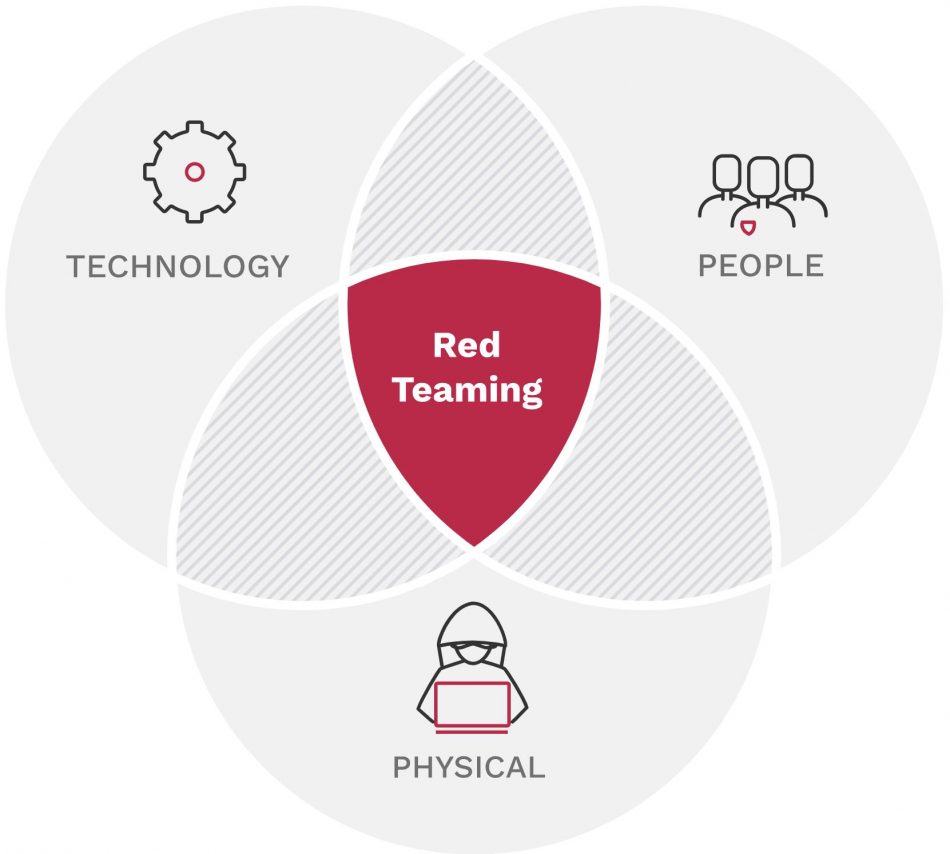RED TEAMING
Test and Strengthen Your Security, Before an Attack
What is Red Teaming?
Of all the available cyber security assessments, a simulated cyber-attack is as close as you can get to understanding how prepared your organisation is to defend against a skilled and persistent hacker.
The main differences between red teaming and penetration testing are depth and scope. Pen testing is designed to identify and exploit as many vulnerabilities as possible over a short period of time, while red teaming is a deeper assessment conducted over a period of weeks and designed to test an organisation’s detection and response capabilities and achieve set objectives, such as data exfiltration. CSG is a leading provider of end-to-end cybersecurity, digital forensics and breach response services. Our Cyber Incident Response experts are skilled at mitigating the damaging effects of cyber-attacks and help businesses efficiently recover from incidents with minimal business disruption and your reputation intact.

A Red Team Operation from CSG is designed to far exceed the remit of traditional security testing by rigorously challenging the effectiveness of technology, personnel and processes to detect and respond to a highly targeted attack conducted over an extended period of time. CSG is a leading provider of end-to-end cybersecurity, digital forensics and breach response services. Our Cyber Incident Response experts are skilled at mitigating the damaging effects of cyber-attacks and help businesses efficiently recover from incidents with minimal business disruption and your reputation intact.
Improve Visibility into Security Gaps
Get an objective perspective on your security blind spots and misconfigured tools and get better visibility into security gaps.
Prioritize Security Budgets
Prioritize the security investments that need to be made, prevent unnecessary spending, and reduce overall security program capital and operating expenses.
Reduce Attack Surface and Risk
Minimize the size of your attack surface, and therefore the risk of a successful attack, by identifying, addressing, and mitigating vulnerabilities and weaknesses across your IT environment.
Ensure Compliance
Ensure compliance with industry regulations, including PCI, SOC2, HIPAA, and other regulations that call for regular penetration testing.
Test Security Tool Effectiveness
Test the effectiveness of the cybersecurity tools and technology you’ve invested in to determine if any vulnerabilities or gaps exist.
Enhance Capacity and Expertise
Develop and enhance your team’s testing and coding capabilities through targeted red team training courses.

CSG’s Red Team Operations experts adopt a systematic approach to comprehensively test your organisation’s threat detection and response capabilities.
Following completion of the red team assessment, a comprehensive final report is prepared to help technical and non-technical personnel understand the success of the exercise, including an overview of vulnerabilities discovered, attack vectors used and recommendations about how to remediate and mitigate risks.
Upon completion of Red Teaming exercises, you will receive a detailed report that:
What is a red team exercise?
Performed by a team of qualified ethical hackers, a red team exercise leverages the latest hacking tools and techniques to launch a simulated cyber-attack designed to thoroughly test an organisation’s security robustness as well as threat detection and response capabilities.
How long does it take to conduct a red teaming operation?
The duration of a Red Team Operation is dependent upon the scope and objective(s) of the exercise. A full end-to-end red team engagement is typically performed over one to two months however specific scenario-based operations with a narrower focus can be performed over 11-18 days. Shorter operations, such as those designed to simulate insider threats, are usually based on an assumed compromise.
A Penetration Test should always document the goals of the project. Penetration Test reports and deliverables outline the expectations, scope, requirements, resources, and results
Could a red team operation cause any damage or disruption?
Unlike genuine cyber-attacks, Red Team Operations are designed to be non-destructive and non-disruptive. By choosing a CREST accredited provider of ethical hacking services, you can be sure that all engagements will be carried out in line with pre-agreed rules of engagement and the highest technical, legal and ethical standards.
What is the difference between pen testing and red teaming?
A penetration test is a focused form of cyber security assessment designed to identify and exploit as many vulnerabilities as possible over a short period of time, often just a few days. Pen tests are often performed to assess specific areas such as networks and web applications.
A Red Team Operation is an extended form of engagement conducted over a period of weeks and designed to achieve a set objective such as data exfiltration, and in the process test an organisation’s detection and response capabilities. Unlike many forms of Penetration Testing, Red Team Operations are conducted to a black-box methodology in order to ensure that engagements accurately reflect the approach of genuine attackers.
